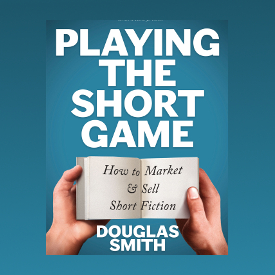Trying something a little different here, creativity-related for sure, but a bit tangental. I want to talk about communication through a creative process.
I’ve had a busy few weeks with my primary income-earning creative talent (the art stuff), and encountered a few things that have been a recurring theme throughout two dozen years of professional art and design. So I thought I’d bring up some of this stuff.
Please do not read them as gripes! I aim to just help people understand what’s going on as that person paints and designs the visuals for your vision. These issues may well translate into other occupations, but I can’t speak to that with experience. As with all things, your mileage may vary.
Without further ado: A guide to communicating with that artist you just hired for your book cover. Or a guide of things for artists to ask an author on beginning a project.
Well first – before the author / person hires the artist:
Choose an artist capable of the style you want. Artists have strengths and weaknesses – things they do well, and things that are out of their oeuvre. You might not ask your SFF author friend to write your bio, or a restaurant review, or to edit your thesis. Just because it seems related since it’s writing or involves words, that doesn’t mean the person’s wired for it. A very gestural watercolorist may not get all the detail you want into that dragon. OR that highly realistic acrylic style may not be within the range of that artist who inks comics.
Look at their work. Some artists do work in a variety of styles – be sure to tell them what caught your eye in this case. Tell them what you’re looking for, ask if they can deliver. If you’ve seen samples of covers or artwork you think would work well for you, that helps, too. What works on them that you think will work well for your book?
Use a contract or basic agreement – something that will protect you both from misunderstandings. Include description, how final will be delivered, whether original is included or just usage rights transferred, how much, due date, sketch / final / pay schedule.
The artist will not likely read your book (or play your game, if it’s lengthy). Some might, but it’s not often done. Reading a book takes time. The cost of the artwork includes some time for research, but probably not the time to read an entire book. The fee covers their artwork & expertise, not their spare time.
Now some may operate on a higher level, and you want to hire them to read your book, play your game, and figure out everything visual for you because you don’t know what you want, or don’t think visually. In that case, the artist would probably charge double what I’d charge, or more.
For the more common experience: Plan on copying some excerpts from your book for scenes and compiling them with relevant character descriptions. You may want to clarify or elaborate on things with content that may not actually be in the book.
As you get that content ready: Think about your scene. Think about your characters. Visualize your cover. Look at other book covers, other art. Decide what you like and don’t like, what’s appropriate and relevant for your book. Be detailed. Skin, hair, eye colors, height and build. Costume details, accessories, weapons. Stance, attitude, expression, mood.
If you need a “bird with blue feathers,” is it crow-shaped, or a hummingbird, is it flightless, or a bird of prey? If you need a “magic sword,” is it a katana or a broad sword or a rapier? Does it glow or have jewels or an inscription? If you don’t know or care – then say so, tell the artist you’re leaving that up to them.
Consider also a more symbolic representation of mood, scene, or character. This may communicate what you need much better over a verbatim accurate depiction of a scene. Compile characters that are important but might never be in the same place at the same time.
And note dynamics between character and scene, character dynamics between each other.
Share any visual research you may have already done. There’s no sense in two different people doing the same search, with one of them guessing what the other might want. In some cases, you, the author, being a creative type yourself, may not want to interfere with the artist’s creative process. But remember – you hired the artist in this situation. The artist will let their own creative vision thrive on their own time, on their own projects! They want to get your vision to you as quickly and efficiently as possible. Rather than let them run with it and then try to steer them back to your vision after they’ve spent a lot of time, cut a clear path, set clear parameters.
If you have a trusted person you’d like to weigh in on the process, have them in on things from the get-go, and confer with each other before suggesting changes or giving directions. Many a time a co-worker or spouse has been brought in mid-way or close to the end of a project, only to give feedback that, if taken, means all but starting over. If you’ve ordered a cake, you don’t want to call the bakery after it’s been put in the oven to say you wanted a marble cake rather than straight-up chocolate. Or, if you do, you might expect them to charge you something for changing the order. There are limits to what that fee covers.
A professional artist who’s done this stuff will likely have taken a few things into consideration when coming up with a price. Time for research, time for sketches & revised sketches, time for painting & some revisions to that.
As you near the end: Don’t be afraid to ask questions and remind the artist of things you requested but haven’t seen addressed yet. I flake out sometimes. I may be so involved with balancing out a major revision that the small and easy detail the author’s already asked twice about just slips my mind. It’s happened!
You can help in that process, too! Try to list revisions and concerns in one email (or whatever your primary mode communication is). If you can do brief bullet points, the better. I often go through paragraphs of feedback and just bold the actual instructions – often just 3 or 5 words out of 48.
You can even think like this when you’re first compiling your cover concepts. You might be an excellent writer and have a wonderful passage you’ve written and want to use for your cover, and I’m not going to tell you not to share that with your artist! Please do!
But you might want to include an additional short list distilled down the important bits. Maybe think about it as how you’d like it if someone were giving you driving directions. “Take a left at the Starbuck’s to turn onto Main Street” is more helpful than “When you get to the Starbuck’s with the lovely pear tree in front of it, and that really cute barista who always draws something funny in my cappuccino foam, take a left onto Main Street, which is where they just had the parade last week…” And maybe that’s why we have GPS things now.
So! That’s about it, at least until I post this and then think of another few things. I hope it helps! If you’ve been on either side of this coin, I’d love to hear your stories. And if you’re an self-publishing author or publishing company, drop me a line. I’m wrapping up 3 awesome projects this week, and looking for the next excellent things to put on my schedule.











Good article. I had a situation where I provided artwork for an author. We had excellent communication, we were on the same page. he provided visual examples, he loved my rough sketches. I provided him with everything that he asked for.
At the last minute he realized that everything that he asked for wasn’t what he wanted. He went with a completely different image (which he obtained elsewhere) on the cover.
He paid me what he promised, and there was (and still is) no hard feelings
You can do everything right, but sometimes it just doesn’t work. That’s the business.
Thanks for your comment!
And yes, that is very true, sometimes things just don’t work. It stinks when it happens late in the process, but I’m very glad that he paid you what he promised. Not all clients respect your time like that!
Note: please accept my apologies in the delay getting back to you, as gmail decided sometime last month to send my notifications to the spam folder.